Newton's Laws are the fundamental principles used to analyze the motion of bodies. Together they form the foundation of classical mechanics.
Newton's Three Laws were first published in 1687 by Isaac Newton (1643-1727) in the three-volume work "Mathematical Principles of Natural Philosophy" (Philosophiae Naturalis Principia Mathematica).
Isaac Newton was one of the most important scientists in history, having made important contributions, mainly in physics and mathematics.
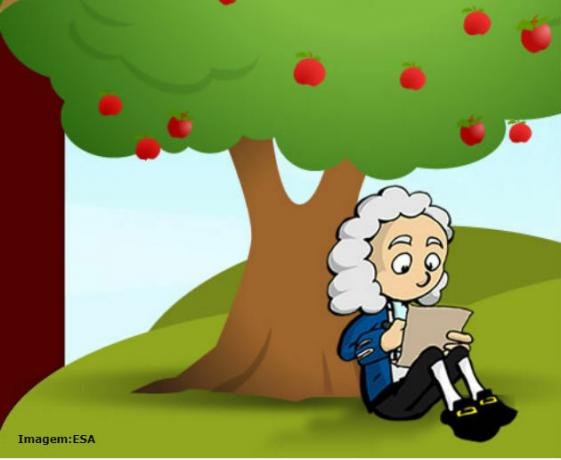
Newton's First Law
THE Newton's First Law it is also called the "Law of Inertia" or the "Principle of Inertia". Inertia is the tendency of bodies to remain at rest or in uniform straight motion (MRU).
So, for a body to leave its state of rest or uniform rectilinear movement it is necessary for a force to act on it.
Therefore, if the vector sum of the forces is zero, it will result in the equilibrium of the particles. On the other hand, if there are resultant forces, it will produce variation in its speed.
The greater the mass of a body, the greater its inertia, that is, the greater its tendency to remain at rest or in uniform rectilinear motion.
As an example, let's think of a bus in which the driver, who is at a certain speed, comes across a dog and quickly brakes the vehicle.
In this situation, the passengers tend to keep moving, that is, they are thrown forward.

Newton's Second Law
THE Newton's Second Law is the "Fundamental Principle of Dynamics". In this study, Newton found that the resulting force (the vector sum of all applied forces) is directly proportional to the product of the acceleration of a body and its mass:
Where:
: resulting from forces acting on the body
: body mass
: acceleration
In the International System (SI) the measurement units are: F (force) is indicated in Newton (N); m (mass) in kilograms (kg) and a (acquired acceleration) in meters per second squared (m/s²).
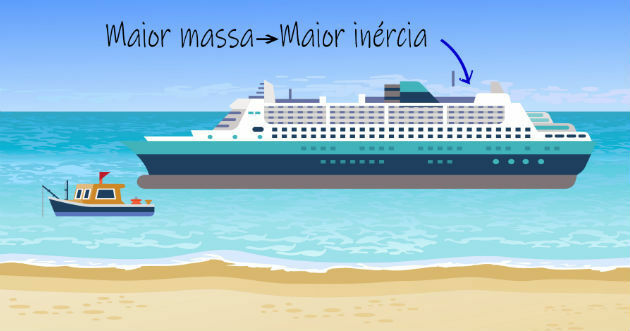
It is important to emphasize that force is a vector, that is, it has a module, direction and sense.
In this way, when several forces act on a body, they add up vectorally. The result of this vector sum is the net force.
The arrow above the letters in the formula represents that the force and acceleration quantities are vectors. The direction and direction of acceleration will be the same as the net force.
Newton's Third Law
THE Newton's Third Law it is called the "Law of Action and Reaction" or the "Principle of Action and Reaction" in which every force of action is matched by a force of reaction.
In this way, the action and reaction forces, which act in pairs, do not balance, since they are applied to different bodies.
Remembering that these forces have the same intensity, same direction and opposite directions.
As an example, let's think of two skaters standing facing each other. If one of them gives the other a shove, both will move in opposite directions.

Newton's Law Summary
In the mind map below we have the main concepts involved in Newton's three laws.
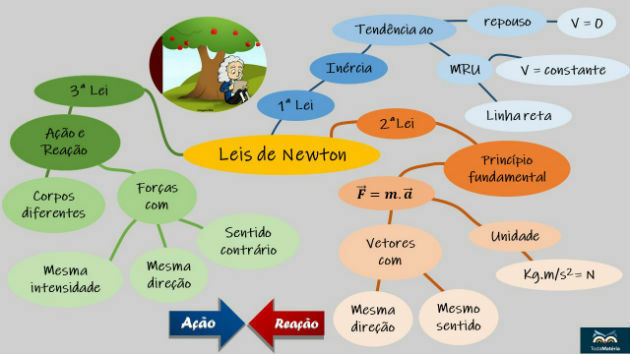
Solved Exercises
1) UERJ - 2018
In one experiment, blocks I and II, with masses equal to 10 kg and 6 kg, respectively, are interconnected by an ideal wire. At first, a force of intensity F equal to 64 N is applied to block I, generating a tension T on the wire.THE. Then, a force of the same intensity F is applied to block II, producing traction TB. Look at the schematics:
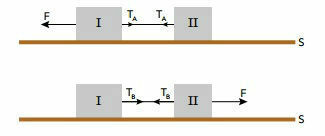
Disregarding the friction between the blocks and the surface S, the ratio between the tractions stands for:
Check out the resolution of this issue in the video below:
Alternative c:
2) UFRJ - 2002
The figure below shows a system consisting of inextensible wires and two pulleys, all of negligible mass. Sheave A is movable, and sheave B is fixed. Calculate the value of mass m1 so that the system remains in static equilibrium.
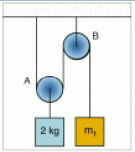
As pulley A is mobile, the tractive force that balances the weight force will be divided by two. Thus, the pulling force on each wire will be half the weight force. Therefore, the mass m1 should be equal to half 2kg.
so m1 = 1 kg
3) UERJ - 2011
Inside an airplane that moves horizontally in relation to the ground, with a constant speed of 1000 km/h, a passenger drops a glass. Look at the illustration below, in which four points on the plane's aisle floor and the position of that passenger are indicated.

The glass, when falling, hits the floor of the plane near the point indicated by the following letter:
a) P
b) Q
c) R
d) S
Alternative c: R
Be sure to learn more about this topic with our exercise text: Newton's Laws - Exercises


